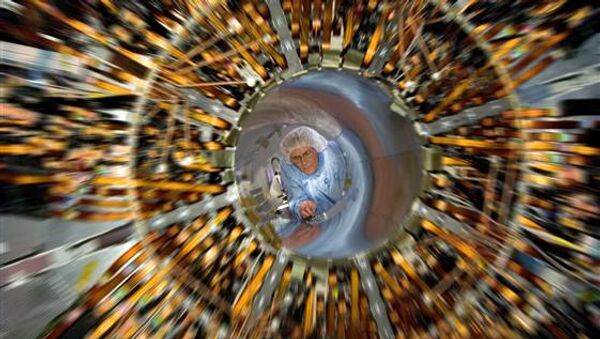The Large Hadron Collider (LHC) set a new record by accelerating its proton beams to half its designed energy - 3.5 tera-electron volts (TeV) - early on Friday, the European Organization for Nuclear Research (CERN) said on its website.
"This is the highest energy yet achieved in a particle accelerator, and an important step on the way to the start of the LHC research program. The first attempt to collide beams at 7 TeV (3.5 TeV per beam) will follow on a date to be announced in the near future," CERN said.
The LHC was restarted at the end of February and repeated its record collision energy output of 2.36 tera-electron volts (TeV) on March 8. Scientists plan to force the particles to collide at 7 TeV by the end of March. The collider will run at 7 TeV through next year, before being shut down for about a year to upgrade to full design energy of 14 TeV.
Speaking at a March 8 news conference, CERN Director General Rolf-Dieter Heuer said the LHC could start generating its first scientific breakthroughs into elusive dark matter as early as later this year, even while operating at half-capacity.
Heuer told reporters then that by now, 5% of the universe can be "explained by the standard model," but if scientists "can detect and understand dark matter, our knowledge will expand to encompass 30% of the universe, a huge step forward."
The $5.6 billion international LHC project has involved more than 2,000 physicists from hundreds of universities and laboratories in 34 countries since 1984. Over 700 Russian physicists from 12 research institutes have taken part.
The collider, located 100 meters under the French-Swiss border with a circumference of 27 km, enables scientists to shoot subatomic particles round an accelerator ring at almost the speed of light, channeled by powerful fields produced by superconducting magnets.
In order to fire beams of protons round the vast underground circular device, the entire ring must be cooled by liquid helium to minus 271 degrees C, just two degrees above absolute zero.
By colliding particles in front of immensely powerful detectors, scientists hope to detect the Higgs boson, nicknamed the "God particle," which was hypothesized in the 1960s to explain how particles acquire mass. Discovering the particle could explain how matter appeared in the split-second after the Big Bang.
Experiments using the LHC were suspended in September 2008 shortly after a successful start, due to a malfunction of two superconducting magnets and a subsequent helium leak into the tunnel housing the device.
Work to repair and upgrade the collider after the breakdown cost almost $40 million and took more than a year. A system to protect it from such accidents, named the Quench Protection System, was installed, and the first beams were injected into the LHC on November 20 last year.
MOSCOW, March 19 (RIA Novosti)



